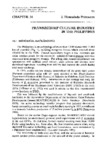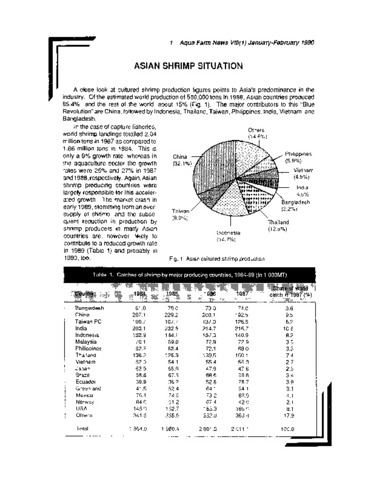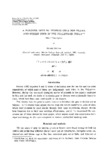Prawn/shrimp culture industry in the Philippines
Share
Abstract
The Philippines is an archipelago of more than 7,100 islands with 17,460 km of coastline, including mangrove forests which covered about 450,000 ha in the 1920s. Coastal aquaculture began a few centuries ago when earthen ponds for the culture of milkfish (Chanos chanos) were first converted from mangrove swamps. For a long time, coastal aquaculture was synonymous with milkfish pond culture; while prawns and shrimps were incidental byproducts resulting from wild fry that entered the ponds during tidal water exchange.
In 1943, studies on low density monoculture of the giant tiger prawn (Penaeus monodon) using wild fry were initiated at the Dagat-dagatan Experimental Station of the Bureau of Fisheries in Malabon, Rizal Province. Information on the ecology and early life history of P. monodon generated by the Institute of Fisheries Research Development of the Mindanao State University (MSU-IFRD) in the early 1970s was used in setting up the first experimental prawn hatchery at IFRD.
This was followed by the establishment of big-tank and small-tank hatcheries at the Aquaculture Department of the Southeast Asian Fisheries Development Center (SEAFDEC/AQD) in Iloilo Province. An active technology transfer program that included short-term, hands-on training courses on small-scale hatchery starting in 1977, contributed to a dramatic hatchery production of 15 million prawn PL in 1978.
Based on the earlier Dagat-dagatan studies, SEAFDEC/AQD started higher-density (semi-intensive) growout pond experiments with P. monodon in the mid-1970's. At that time, farmers started stocking more than 10,000 PL/ha using hatchery fry. Soon after, the first intensive culture trials, using imported Taiwanese technology and feed formulations were undertaken by a Philippine food conglomerate.
The availability of both seed and feed, and the attraction of lucrative export market prices contributed to the take-off of the prawn industry. In 1983, when the country's 56 hatcheries produced 85 million PL's, and commercial pellets for intensive culture first appeared in the market, pond production totalled 12,100 MT, a quantum leap from a harvest of only 1,800 MT the previous year.
Since then production of PL, adults and exports have steadily increased to a peak of 20,000 MT of exports from 40,000 MT of pond harvests in 1988. The following year the bubble burst. From a high of P200/kg (US$1 =P21) in 1988, farm gate prices plummeted to as low as P70/kg in mid-1989 due to Southeast Asian excess production of black tiger prawn, and to prawn exports from China glutting the Japanese market.
This chapter discusses the various components of the Philippine prawn industry with a focus on growout, problems of the farming sector, and problems of the industry as a whole. Lastly, recommendations are offerred for long-term viability.
Description
Bacterial diseases of penaeid shrimps: an Asian view.
Suggested Citation
Primavera, J. H. (1992). Prawn/shrimp culture industry in the Philippines. In A. W. Fast & L. J. Lester (Eds.), Marine Shrimp Culture: Principles and Practices (Developments in Aquaculture and Fisheries Science Vol. 23, pp. 701-728). Amsterdam: Elsevier.
Subject
Taxonomic term
Collections
Related items
Showing items related by title, author, creator and subject.
-
Asian shrimp situation
Carreon-Lagoc, Julia; Southeast Asian Fisheries Development Center, Aquaculture Department (Aquaculture Department, Southeast Asian Fisheries Development Center, 1990) -
A guide to small-scale marine finfish hatchery technology
Sim, Sih-Yang; Rimmer, Michael A.; Toledo, Joebert D.; Sugama, Ketut; Rumengan, Inneke; Williams, Kevin; Phillips, Michael J. (Network of Aquaculture Centres in Asia-Pacific, 2005)Recent improvements in hatchery production technology for high-value marine finfish species such as groupers have led to an increased interest in setting up hatcheries to produce fingerlings for aquaculture. Small-scale ... -
A further note to “fishing gear for prawn and shrimp used in the Philippines today”
Motoh, Hiroshi (Carcinological Society of Japan, 1983)Motoh (1980) reported 9 and 13 kinds of shrimping gear for the fry and the adult respectively, of which most of them are indigenously used today in the Philippines. Howerver, druing the continued ecological survey of ...





